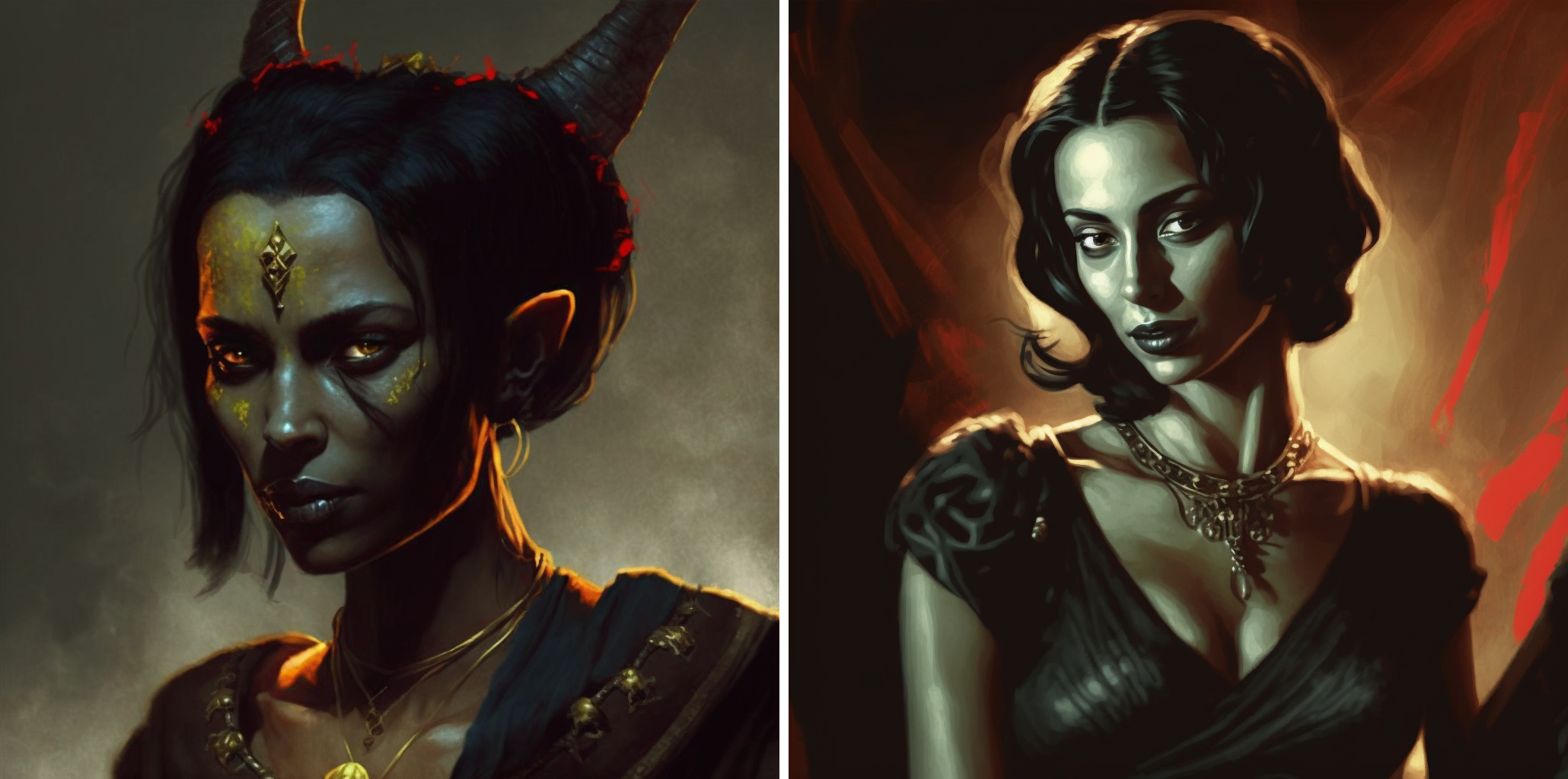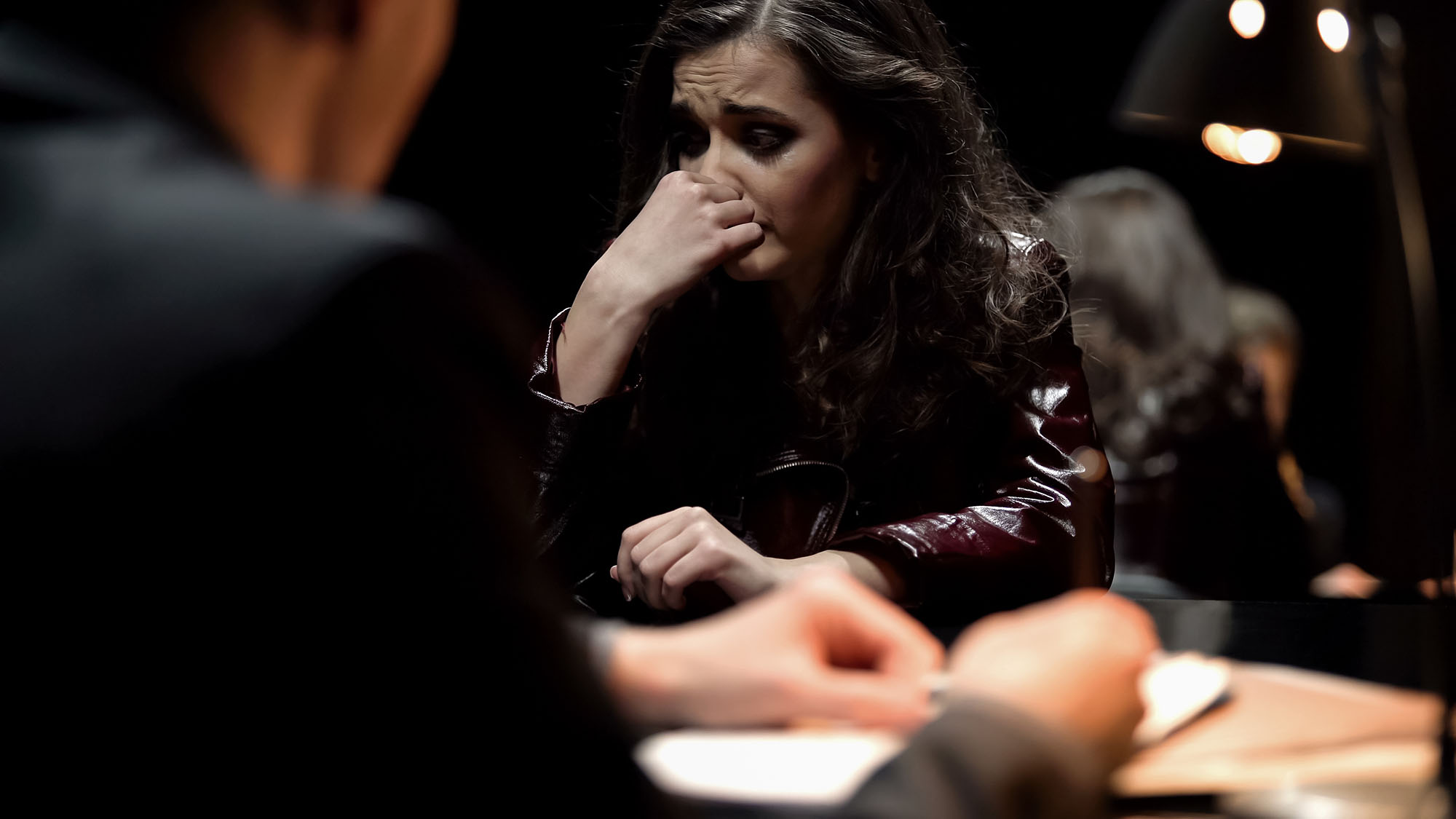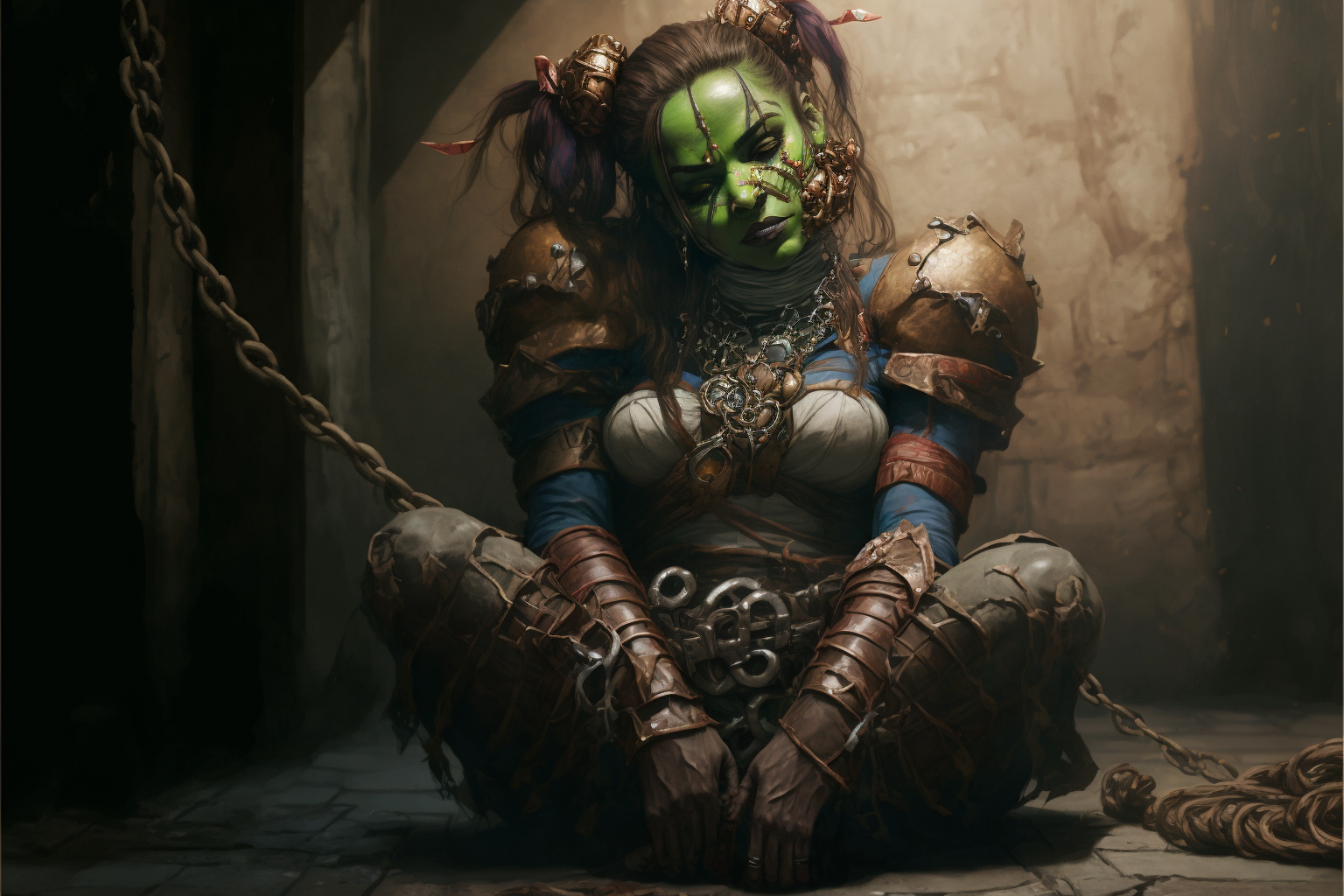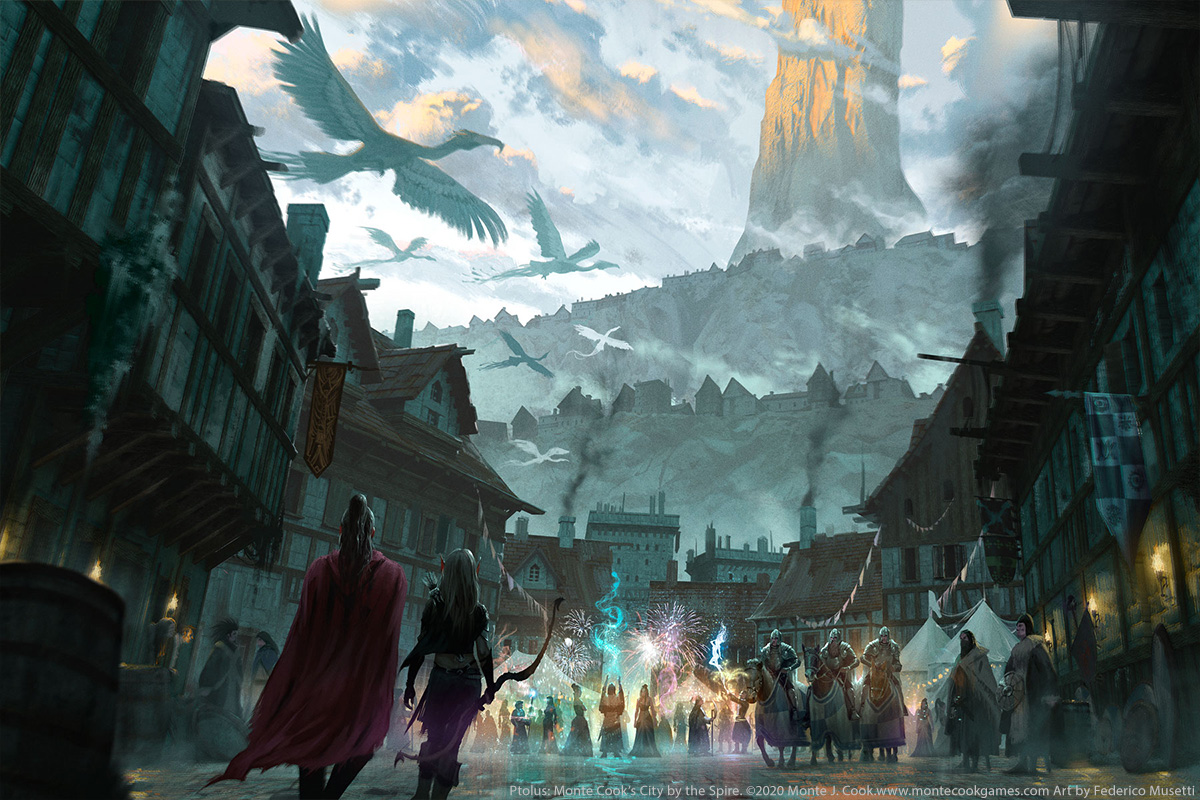
Iristul Vladaam is not currently located in Ptolus, and is not further detailed here. Each Vladaam heir, however, is detailed with:
- A universal roleplaying template, as detailed here, for easy use.
- Connections to other factions, scenarios, or major players in Ptolus.
- Responsibilities, which summarize which aspects of the Vladaam deot they oversee.
- A schedule of their activities, as detailed below.
Along with any additional details that are relevant.
FAMILY SCHEDULES
Schedule information is given below for each family member. If a specific investigation is made into the schedule of a specific heir, a Charisma (Investigation) check (DC 15) turns up one piece of information plus one additional piece of information for every 4 margin of success.
Use the following table to determine what sort of scheduling information is gained:
| 1d4 | Type of Schedule Information |
|---|---|
| 1 | Regular Activity |
| 2-3 | Recent Activity of Interest (random table) |
| 4 | Upcoming Planned Activity (random table) |
Note that the same random table is used for both recent activity and upcoming planned activity. Some of these activities may be one-time events; others might be something that happens semi-regularly. (Use your best judgment to determine whether or not to repeat certain events.)
ALIASTER VLADAAM

APPEARANCE: Bushy sideburns down to his jowls. A man in his fifties. Six fingers on each hand (and six toes on each foot).
- GM Note: His eyes are completely black. (But he wears magical lenses to make them appear normal.)
ROLEPLAYING:
- Lacks ambition and drive, but makes up for it with a thirsting desire for knowledge.
- Extreme cowardice.
- Jut the head forward and down; the eyes looking slightly up at anyone standing across from him.
- Traces figures in his left palm with his right index finger.
BACKGROUND: Aliastar is on friendly terms with Navanna and has no interest in vying with her for control of the house. He manages only those concerns within the deot that he finds personal interesting (primarily matters of magic or alchemy or, lately, chaositech).
Aliaster helps his half-sister with her schemes by casting spells on her or for her in the simple hope that she will leave him alone and not actually force him into a dangerous situation.
STATS: Ptolus, p. 101
CONNECTIONS
Aliaster is part of the thoughtstone network. (Ptolus, p. 158)
RESPONSIBILITIES
Aliaster handles anything magical or alchemical in the family’s portfolio. This includes:
- Alchemical Labs (Part 7)
- Red Company of Fletchers (Guild – Dreadwood Grove)
- Red Company of Founders (Guild – Founders’ Workshop)
- Oldtown Apartments (Part 15)
- Red Company of Magi (Part 13)
SCHEDULE
Regular Activity: Visits Haven’s Haven every Fireday to shave and trim his beard.
| 1d6 | Random Activity |
|---|---|
| 1 | Crown Theater (Ptolus, p. 268): Attending Lothian Ascendant, an experimental opera sponsored by Adlam Theobald. |
| 2 | Tess’ Cauldron (Ptolus, p. 313): Aliaster is trying to convince Tess Essani to join the Red Company of Magi. (It’s possible he’s romantically interested in her.) |
| 3 | Winsome Galleries (Ptolus, p. 277): Aliaster dabbles in magical sculpture (pieces that move; pieces that create charm effects; compositions of magical light; magic mouth statuary; etc.). He will occasionally deliver some of these pieces to the Winsome Galleries for sale. |
| 4 | Attending a guild meeting of the Red Company of Magi. |
| 5-6 | Oldtown Apartments: He’s here most days studying the askara or artifacts Navanna is pulling out of the Banewarrens. |

Aliaster’s Arcane Sigil
GATTARA VLADAAM

APPEARANCE: A round face and shoulder-length, dark brown hair with reddish tints. She wears scandalously revealing garments and large, glittering jewelry much of the time.
ROLEPLAYING:
- Hopelessly mad, given to fits of irrational rage without notice.
- A high-pitched, tittering laugh.
- A raw, desperate flirtation that craves a mixture of acceptance and adoration. (Can easily flip into a cruel sadism.)
BACKGROUND: Once thought a promising wizard, she gave up her studies to serve as a priestess to the Galchutt. She maintains a fancy of opening a temple to the Galchutt in the Temple District (perhaps even using the Abandoned Temple of the Great Mother, see Part 6), but there is nothing concrete to any of it.
She has some contact with the chaos cults, but no direct contact with Wuntad. (He was initially intrigued, but he considers her madness and her irrational fervor too much of a liability.) Gattara has convinced Navanna to provide supplies to the chaos cults through various parts of the Vladaam deots.
Despite her madness (or perhaps because of it), she serves as something of the “family sage.”
STATS: Ptolus, p. 608
CONNECTIONS
BALACAZARS: Gattara has been good friends with Malkeen Balacazar (Ptolus, p. 103) since childhood. Rumors of them being lovers are false, but Malkeen will regularly consult with her regarding sorcerous matters – particularly those of the macabre or sadistic bent that he knows she will enjoy.
MARCUS CORELLIUS: Gattara has a good (and periodically intimate) relationship with Den Master Marcus Corellius (Part 8: Curse Dens). Although Godfred is technically in charge of the curse dens, Gattara liaised with Corellius regularly regarding the slave trade cover operations (Part 16).
THOUGHTSTONES: Gattara is part of the thoughtstone network (Ptolus, pg. 167)
RESPONSIBILITIES
Gattara likes slaves. She really, really likes them. Navanna generally leaves her to it, although she makes a point of regularly checking the books.
- Part 16: Slave Trade
SCHEDULE
Regular Activity:
- Danbury’s (Ptolus, p. 192): Socializing at this tavern for wizards and sorcerers three nights out of four.
- Jade Woman (Ptolus, p. 277): Visits roughly once a week to shop for a new set of garish outfits.
| 1d4 | Random Activity |
|---|---|
| 1 | Curse Dens (Part 8): Gattara likes to play with the slaves in the curse dens. She favors the Rivergate location, where she can also meet with Den Master Corellius. |
| 2 | Soaring Idyll (Ptolus, p.276): Gattara likes to use the Idyll for her sexual liaisons. (There is a 50% chance this involves Den Master Corellius.) |
| 3 | Shadow Theater (Ptolus, p. 310): Gattara has been regularly attending performances and has been going backstage in an effort to learn the shadow-magic arts of the performers. She has also met Renn Sadar (Ptolus, p. 99) in the audience on a few occasions. (Note: Tellith’s father is the manager of the theater. She’s somewhat estranged from him because he’s terrible at business and left her and the mother in poverty for much of her childhood. See the Ghostly Minstrel, Ptolus, p. 194.) |
| 4 | Onyx Spider (Ptolus, p. 203): Meeting with Malkeen Balacazar. |
GODFRED VLADAAM

APPEARANCE: Tall, dark-haired, and pale, with extremely broad shoulders. Thick hair and bushy eyebrows. A long scar down one side of his often unshaven face.
ROLEPLAYING:
- Slow witted and rash. A lumbering oaf.
- Haughty, with an immense sense of entitlement.
- Looks down his nose (literally) at anyone he deems to be a lesser being… which is virtually everyone.
BACKGROUND: Youngest of the heirs and Iristul’s favored, but Iristul is smart enough to know that the boy isn’t capable of being in charge.
Godfred is a master of the greatsword and wields the only hungersword Iristul has yet found.
STATS: Ptolus, p. 102
CONNECTIONS
None of note.
RESPONSIBILITIES
Navanna has handed over responsibility for the drug-running activities of the Vladaam deot to Godfred and, with them, the family’s shipping concerns. This is ideal because these aspects of the deot largely run themselves (either through the Fleet of Iron captains or the Red Company of Surveyors), and she also figures that if these activities were to ever blow up, she could lay the whole thing on Godfred and call it a day.
- Curse Dens (Part 8)
- Fleet of Iron Sails (Part 9)
- Red Company of Surveyors (Part 14)
- Vladaam Drug Running (Part 18)
SCHEDULE
Regular Activity: Godfred’s entire schedule is relatively predictable. The White House, Lady Cardie’s, and the Waterfall are all basically daily activities for him. The Arena is only irregular because it largely depends on when his fighter is scheduled.
| 1d8 | Random Activity |
|---|---|
| 1 | Arena (Ptolus, p. 292): Godfred has been sponsoring a fighter named Cardric Dragonkin. |
| 2-4 | White House (The Mrathrach Agenda): He’s been gambling here regularly. |
| 5-6 | Lady Cardie’s (Ptolus, p. 313): Visits this brothel on most nights. (It is also a front for the Vai, and he’ll use the visits to arrange for assassinations and hits. See Ptolus, p. 131.) |
| 7-8 | The Waterfall (Ptolus, p. 324): Godfred’s favorite bathhouse. |
NAVANNA VLADAAM

APPEARANCE (GLAMERED): A black dress with burnished armlets which send patterns of magical shadow writhing up her arms. A large glittering ruby in a simple fixture of taurum has been affixed directly to her breastbone. All of this stands out starkly and sharply against her dusky skin.
- GM Note: The ruby functions as a hat of disguise.
APPEARANCE (ACTUAL): Short-haired, pointy-chinned, extremely fit and thin. Her hair is dark brown and her skin is extraordinarily black – almost blue. Her teeth are bright yellow and she has four tiny red horns on her forehead right at the hairline.
ROLEPLAYING:
- Polite, charming, and perfectly willing to stick a dagger into your back at the first opportunity if there’s any profit in it.
- Coolly asexual, although she can drape other personalities (from femme fatale to gregarious bard) onto her false identities.
- If driven to true fury, she hisses like a cat. (She has not hissed in years.)
BACKGROUND: While Iristul is away, Navanna runs House Vladaam. Like her siblings, she is wicked and cruel – but she is also extremely devious and painstakingly cautious. She is not the most powerful of the family, nor the eldest, but she is the best leader.
KEY INFO: Navanna is constantly accompanied by at least four of the Twelve Claws (her personal werewolf bodyguards; see Part 5: The Vladaam Estate).
STATS: Ptolus, p. 101
CONNECTIONS
- Renn Sadar (Ptolus, p. 98)
- Commissar Igor Urnst (Ptolus, p. 140)
- City Council (Ptolus, p. 140)
- Menon Balacazar (Ptolus, p. 103)
RESPONSIBILITIES
Navanna officially runs the deot of House Vladaam while Prince Iristul is away. Although certain aspects of the deot are handed off to her siblings for daily operations, she still oversees everything.
- Abandoned Temple of the Mother (Part 6)
- Ithildin Couriers (Part 1)
- Red Companies (Part 1)
- Undead Shipping Warehouse (Part 17)
- Vladaam Family Estate (Part 5)
SCHEDULE
Regular Activity:
- Visits the Winsome Gallery (Ptolus, pg. 277) every week on Airday to see the latest arrivals and occasionally purchase pieces she fancies.
- Meeting of City Council. (1 in 6 chance of meeting each day. She has, however, been leaving a larger number of votes in the Trade Circle to the family’s proxies.)
| 1d8 | Random Activity |
|---|---|
| 1 | Aristocrat’s Table (Ptolus, p. 284): 1 in 4 chance of meeting Red Company leader, otherwise she’s dining alone. |
| 2 | City Courts (Ptolus, p. 318): She’s seeking reparations from the city for their “occupation”of the Oldtown Apartments (Part 15, this is dependent on events from the Night of Dissolution). |
| 3 | Meeting with Menon Balacazar. |
| 4 | Meeting with Renn Sadar. |
| 5 | Meeting with Adlam Theobold: She’s interested in the church’s involvement with the Banewarrens. (This is dependent on events from the Banewarrens, otherwise re-roll.) |
| 6 | Arena at the Dark Reliquary (Ptolus, p. 237): PCs can try to wrangle an invitation by making a complex Charisma (Investigation) check (DC 20/4/3). For each failure, someone becomes aware of their attendance (Vladaams, chaos cults, Lilith, Vai assassins, etc.). |
| 7-8 | Tends to disappear (or at least become unaccountable) for large stretches of time. (If she has become aware of the Banewarrens, these periods have increased in frequency since that time.) See “False Identities,” below. |
NAVANNA’S FALSE IDENTITIES
Navanna maintains a number of false identities in the city. She is constantly discarding old identities and creating new ones as opportunities and needs arise.
Navanna will use her ruby of disguise and then simply teleport out of the Vladaam House Estate. Some of her identities maintain rooms at the Soaring Idyll across the street (so she simply teleports there). She also rents a room in Oldtown almost directly below the House Estate and she can teleport there.
ELLA FENRIS: A swarthy-skinned half-orc. Master Delver of the Delver’s Guild (Ptolus, p. 108). Rarely goes on actual delves, but uses guild contacts to find out the latest discoveries beneath Ptolus.
IDORU: As Idoru, Navanna works as a freelance representative of the Eight Shadows (Ptolus, pg. 377). In that role, she either approaches (or is approached by) would-be clients of the Eight Shadows (either for vile fantasies at their brothel or, more likely, their job as drug dealers, assassins, spies, and enforcers). The Eight Shadows are part of the Balacazar criminal cartel, but neither they nor the Balacazars know that Idoru is secretly Navanna.
NICALON REGELIS: A new member of the Knights of the Golden Cross (Ptolus, p. 120). Spread story of being recently imprisoned by the Vladaams and would speak out strongly against the House in order to find out what her enemies have to say. She sacrificed this identity (blowing months of work) in order to identify the Hand of the Banelord and steal it from the PCs. See Banewarrens, p. 42.
OALA: A hostess at the Onyx Spider (Ptolus, p. 203). The owner of the Spider knows that Oala is an agent of House Vladaam, but doesn’t realize she’s actually Navanna in disguise. Navanna finds it useful to be able to move freely through the crowds here, eavesdropping wherever it seems wise.


















